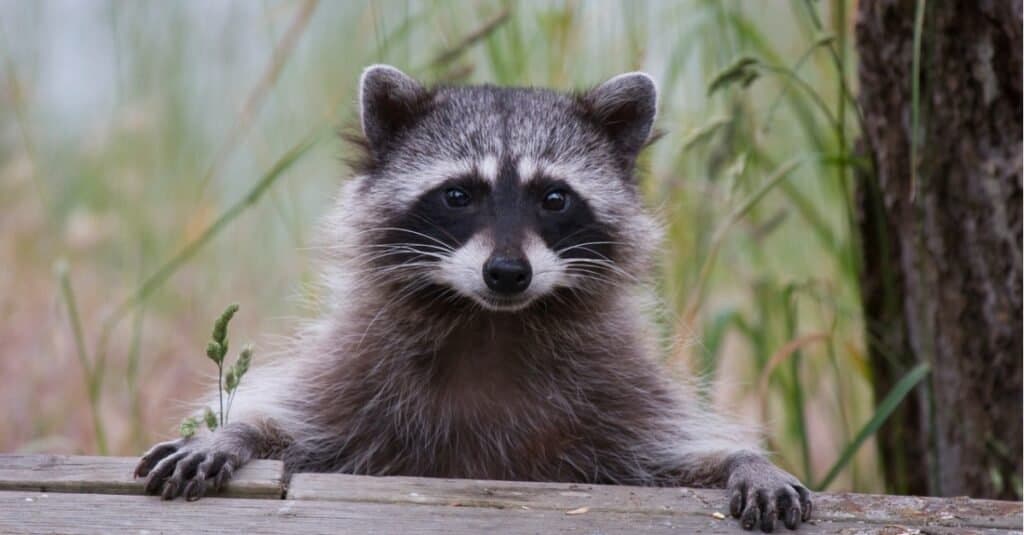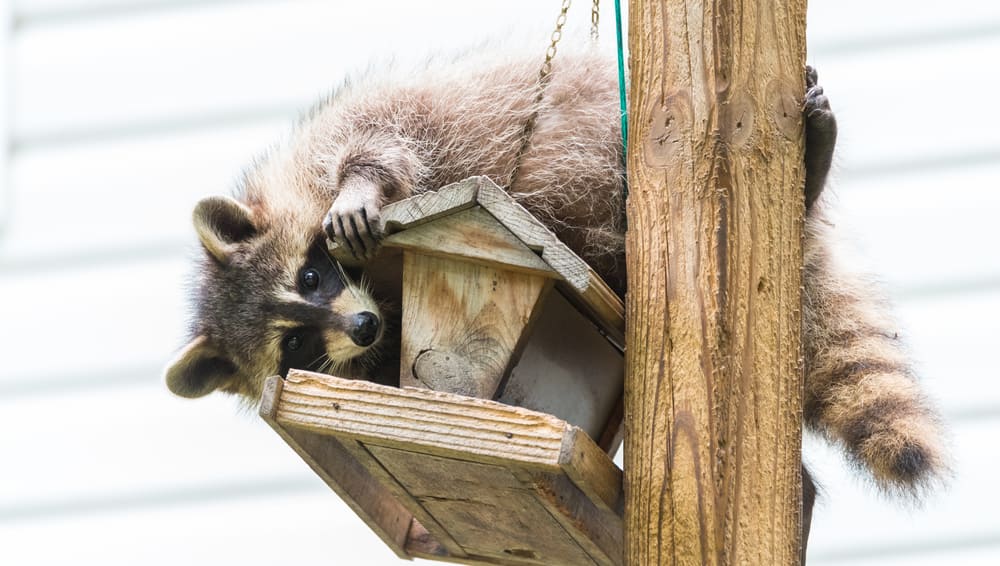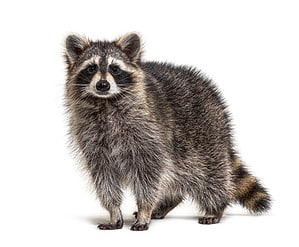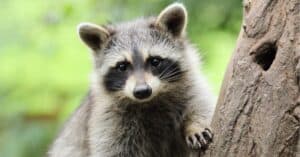Nearly everyone in North America has seen a sneaky trash panda raiding their garbage cans. Also known as trash bandits, the sly raccoon (Procyon lotor) with its trademark mask is an expert at getting into things it shouldn’t. However, this mammal doesn’t just rock a mask to look devious — and its dark facial fur is more than just a fashion statement. Learn the reason for these eye markings, along with a few other raccoon facts you may not know.
1. Enhanced Visual Perception

Raccoons got the nickname “trash pandas” due to their markings and their habit of raiding garbage cans.
©iStock.com/cullenphotos
The black around a raccoon’s eyes is actually a very important feature. A raccoon’s mask functions much like a football player’s glare-reducing eye black. The black fur absorbs light and makes it easier to see clearly in bright light. It also reduces glare at nighttime to improve their nocturnal vision.
Raccoons are nearsighted, which means they see up-close more easily than at a distance. It is believed that they are either colorblind or at least poor at distinguishing between colors. However, raccoons’ eyes are well developed to see at night, and they make up for any vision deficits with an amazing sense of hearing and touch.
2. They Are Expert Climbers

Only a few species climb down trees headfirst, including raccoons, squirrels, red pandas, and kinkajous.
©StoneMonkeyswk/Shutterstock.com
Your 6-foot fence poses no challenge for a raccoon. Raccoons are excellent climbers, and can easily scale vertical surfaces like fences, walls, and trees. In 2018, a Minnesota raccoon became internet famous after climbing a 25-story skyscraper all the way to the roof. The raccoon scaled the outside of the UBS Tower in Saint Paul with ease, taking breaks to sleep on windowsills along the way.
A raccoon’s ability to climb so well is due largely to its dexterous front paws and sharp claws that help them grip surfaces. Thanks to their flexible ankles, they can rotate their hind feet around 180 degrees to find a better grip. This also helps them climb down surfaces headfirst like a squirrel.
Because raccoons are such good climbers, they have no trouble getting onto roofs and into attics. Attics are a favorite place for raccoons to make dens because the areas are sheltered, dry, quiet, and safe. They also have the added bonus of being close to human food sources. In urban areas, a raccoon’s territory usually spans only around one mile from its den, so making a home somewhere with convenient access to food sources is a must (and it never hurts to have central heating!).
3. They Have Unique Hands

While raccoons have five toes like primates, they do not have opposable thumbs.
©Sandra-Dombrovsky/Shutterstock.com
Speaking of those dexterous paws, a raccoon’s feet are incredibly unique. While they do not have opposable thumbs like people, raccoons have feet that resemble human hands. These feet allow them to easily hold and grip objects in their front paws.
A raccoon’s hands also give it an incredible sense of touch. Raccoons have more sensory cells in their hands that react to stimuli than other mammals. These cells, called mechanoreceptors, register pressure, touch, force, and motion. Researchers believe that raccoons seen washing their hands before eating are increasing the tactile nerve endings in their paws. Wetting their paws increases the already honed sensitivity to further increase their tactile senses.
And their tactile senses are already impressive, with five times more mechanoreceptors than other mammals. In fact, a raccoon’s sense of touch is second only to that of primates.
4. Female Raccoons Are Monogamous

Raccoon babies are raised exclusively by their mothers. Males take no part in raising the young.
©Tyler Plum/Shutterstock.com
While male raccoons are polygamous and mate with multiple females during the breeding season, females are more selective. Females mate with only one male per year.
These approaches have benefits for both males and females. Mating with multiple females provides males with more opportunities to father offspring. For females, having only one mate protects her young from other challenging males. While male raccoons are solitary, females form close family groups of up to a dozen raccoons. These groups sometimes stick together for years, raising their young communally.
Raccoons have one litter per year and usually give birth to three to five kits per litter. Breeding happens in late winter. After a 60-day gestation period, babies are typically born in early spring (between March and April). The kits stay with their mother for up to a year before striking out on their own.
5. Raccoons Are Geniuses

Trash pandas are opportunistic omnivores that will happily eat seed from bird feeders.
©valleyboi63/Shutterstock.com
Fifth on our list of raccoon facts is their intelligence! These animals may look bumbling, but they are incredibly smart. The raccoon has an average IQ level ranking just below monkeys, and well above the intelligence of cats and dogs. Raccoons have good problem-solving skills and can learn — and remember— solutions to complex problems. Once they figure out how to get into a garbage can, they will remember!
The raccoon’s ability to learn quickly is one reason it is such a well-adapted animal. Raccoons can live in just about any environment and adapt to meet changes in those environments. Using what they’ve learned in the past, they can solve new problems.
In one study, 20 raccoons were given an elaborate puzzle box. The majority of the raccoons were able to find several different solutions to the multi-solution box. Twelve of the 20 were determined to be “not only capable of innovative problem solving, but also of repeated innovations during a novel foraging task.”
6. They Rub Shoulders with Presidents

In September 2020, four raccoons invaded the White House’s North Lawn, chasing journalists.
©Vacclav/iStock via Getty Images
When it comes to raccoon facts, we can’t forget the most important one. Maybe the biggest nod to how special raccoons are is the fact that they’ve visited — and even lived — in the White House! In January 1914, “Ben” the raccoon was brought to the White House by Edward Goltra, a Democratic National committeeman, to meet President Woodrow Wilson. While Wilson was out for a round of golf, Ben got into a scuffle and lost one of his teeth. Goltra was so impressed by Ben’s toughness that he had a dentist replace the missing tooth with a gold one.
While Ben made an appearance at 1600 Pennsylvania Avenue, the most famous White House raccoon was Rebecca. Originally given to President Calvin Coolidge in 1926 to be eaten for Thanksgiving, the Coolidge family fell in love with the raccoon and kept her as a pet. Rebecca was frequently taken out on a leash, as she had a tendency to run off and play hide and seek. A male raccoon named Rueben was brought to the White House to be Rebecca’s boyfriend, but she was uninterested. Apparently not one for the presidential life, Reuben eventually escaped over the White House fence and never returned.
Rebecca lived at the White House with the Coolidges until the end of the presidency. At that point, she was rehomed to Washington’s Rock Creek Zoo so that she could live with other raccoons. Shortly after her departure, a Virginia opossum moved into her outdoor pen on the White House grounds. Dubbed “Billy Possum,” Billy lived at the presidential home throughout the Hoover presidency.
The photo featured at the top of this post is © iStock.com/SergeiM
Thank you for reading! Have some feedback for us? Contact the AZ Animals editorial team.







